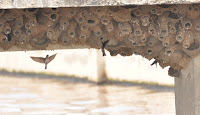Location: Jogi Kere, near Thallagatapura, Bangalore
Date: Mar 4th, 2021
To get there: [Click here for Google Map].
It is located in South Bangalore on Kanakapura Road in Judicial Layout, Thallagatapura.
Trail type: Paved walking path going around the Lake for 0.5 km
Facilities: None at the lake as of now. Sometimes we travel a long distance to see birds but ignore good birding places in our neighborhood gardens and nearby lakes. For these, all you need is a couple of hours of free time. Binoculars and shoes are optional! Previously, I had written about other city lakes, Puttenahalli Kere and Doddakallasandra Lake. This time, we visited one such lake, smaller but close enough to just walk to it.
Jogi Kere is that water body to which we paid a visit, a mere 1km walk from our residence.
Kere translates to lake in Kannada language and
Jogi means a hermit in many Indian languages. Surely, this lake is where one can meditate in the midst of nature! Jogi Kere will barely make the cut as a lake, but it has been cleaned up recently by local folks, government agencies, and NGOs. Sewage inflow is cut for the most part and the foliage in the island and boundaries are beginning to show signs of recovery. The lake itself, unfortunately, follows the ill-advised design of a soup bowl with rocky embankment all around and a walking path on the bund thereby denying the much-needed shore and vegetation near the waterbody for birds to thrive. But somehow nature overcomes and thrives!

It was a sunny weekday morning when 6 adults and 4 kids which formed our group started out after 7am on the path towards the lake. It passed through some undeveloped land with plenty of shrubs and trees. So, our birding started early as we spotted wagtails, robins, parakeets, bulbuls, etc., and stretched a 15 min quick walk into a 45 min exciting stroll. We could hear the Red-wattled Lapwing calling as we neared the lake. There is only one entrance at a corner and we were greeted by a mixture of water birds immediately, as we passed through it. Spot-billed ducks, Little Grebe, Little Cormorant, Eurasian Coot, Common Moorhen were on the welcoming committee. As we took in the birding bounty, there was a lot of energy and commotion on the large tree opposite dominated by Rosy Starlings, Mynahs, and Parakeets flying in and out constantly. A solitary Coucal decided to join the fun by hopping over the fence and climbing the tree. We suddenly saw a flash of blue streaking over the water and perch on a concrete platform nearby. Lo and behold, the very colorful Common Kingfisher had made its appearance and obliged us by staying there for a while. Walking around the lake we managed to spot few more birds like Pond Heron, Indian Robin, Pied Bushchat under the constant chatter of the migratory Starlings which were there in huge numbers.

After a leisurely stroll around the lake, we walked across the road to check in on an abandoned quarry opposite the lake which because it's isolated completely usually has some surprises. This time it was a flock of 10 Lesser Whistling-ducks and a solitary Purple Swamphen among other water birds. By this time the sun was up and it started getting hot. We headed back to our place and finished the neighborhood lake bird walk in around 2 hours.
Overall, it was a wonderful experience for all. Easy walk to experience a healthy urban bird diversity spot in our neighborhood itself. Good luck and kudos to all the workers and volunteers, who are making this experience possible and fighting to retain the water body without letting it get destroyed or encroached. Bangalore needs every one of these gems, big and small, to remain in a healthy natural state for the survival of our feathered friends.
Selected images taken during our visits here can be viewed at the link below.
Jogi Kere Bird Images
Checklist of birds seen on Ebird












